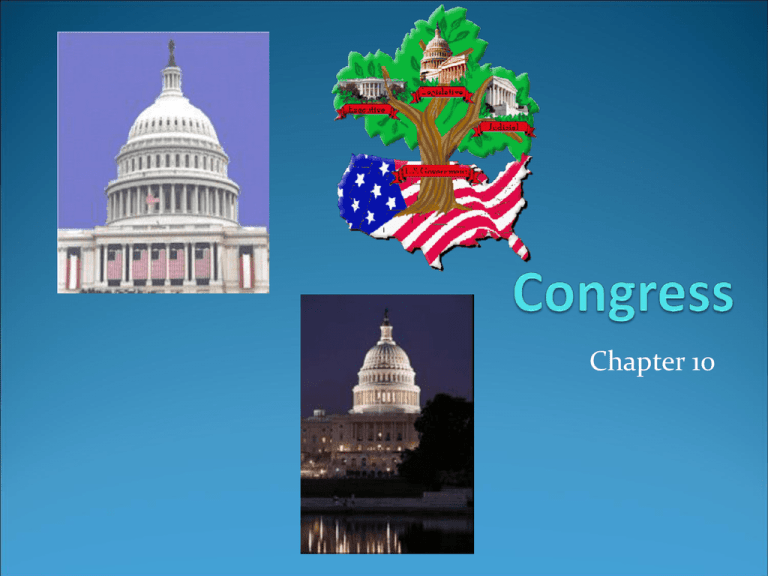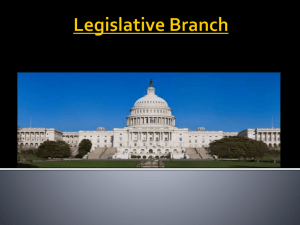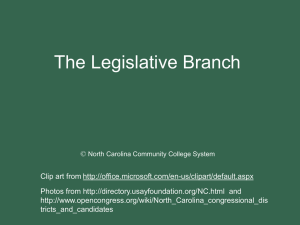Congress
advertisement

Chapter 10 The Evolution of Congress Congress as the central lawmaking body was a unique invention – rule by emperors or kings was the common method The intent of the Framers: • To oppose the concentration of power in a single institution • To balance large and small states and checks and balances (bicameralism) • House - closer/more accountable to the people 2 year elections, smaller districts • Senate - more elite, aristocratic, educated than House, closer to President 6 year elections, represent entire state, stricter qualifications They expected Congress to be the dominant institution but limited by checks The “First branch” of American government Has the “power of the purse” BUT checked by president’s veto power (even though Congress Can pass a law even if president vetoes it) Only legislature that exercises almost independently of executive Checked by Supreme Court – laws can be deemed unconstitutional Virginia Plan New Jersey Plan Connecticut Compromise The Legislative Compromise Recall the Great (Connecticut) Compromise creating the legislative lawmaking branch of government Congress is a bicameral legislature with: two coequal houses with substantially equal powers; and in particular, legislation (laws, policy, public policy) requires the support of a concurrent majority in both houses (51% in both houses) In the House of Representatives, states have representation proportional to population Members serve two-year terms. Representative districts = smaller areas (Hialeah, South Miami, L.C.) In the Senate, states are equally represented (2 Senators/state) The size of the Senate =100 members Senators serve staggered six-year terms. Senate “districts” = states. Since ratification of the 17th Amendment (1913), Senators have been in the same manner as Representatives. Major Functions of Congress Representative of the people Closer to the people and directly elected by the people (smaller group, inhabitants of area) Lawmaking (public policy = law) Congressional powers defined in Article I, Section 8 (taxes, interstate and foreign commerce, *elastic clause) Consensus building (amongst parties) Special, Exclusive powers: House – Revenue bills must originate in the House (though usually happen simultaneously) and impeachment power (officials charged in the house of high crimes) Senate – Confirms major presidential appointments, makes treaties with foreign nations (along with president), and holds hearings for impeached officials Congress Evolutionary powers (due to elastic clause) – oversight of the budget ($ and presidential proposals approved by Congress), investigation and hearings of public officials Constitutional Differences House of Representatives Senate 2 year terms, unlimited 6 year terms, unlimited 435 members (proportional 100 members (equal representation-2 representation) – changes every 10 year per state) initially elected by state with census legislatures - considered “Millionaires’ Club;” 17th Amendment (1913) made popular election of Senators Initiates all “money” bills (taxation and spending) “Advice and Consent” on president’s appointments and treaties Initiates impeachment proceedings Tries impeached officials 25 years old, 7 years a citizen 30 years old, 9 years a citizen HOUSE OF REPRESENTATIVES SENATE MEMBERSHIP 435 members (apportioned by Congress) 100 members (two from each state) TERM OF OFFICE 2 years; entire House elected every 2 years 6 years; staggered terms with 1/3 elected every two years QUALIFICATIONS At least 25 years old Citizen for 7 years must live in state where district is located At least 30 years old citizen for 9 years must live in State CONSTITUENCIES Smaller, by districts Larger, entire state PRESTIGE/POWER Less prestige/power More prestige/power IMPEACHMENT Initiates impeachment proceedings (impeachment=formal accusation) Conducts trials of impeached MONEY BILLS- TAX AND SPEND/REVENUE Must start in House (goes to Ways and Means Committee) ---- ORGANIZATION Very formal, many detailed rules Less formal, traditions followed RULES COMMITTEE Powerful house committee, sets terms of debate for a bill (power to kill a bill) NO RULES COMMITTEE- lack of rules allows for filibuster to occur BILL AMENDMENTS Must be germane (relevant) to the bill topic NON germane (relevant) allowedallows for riders or Christmas tree bills Voice-most common Teller Standing Roll call-Electronic Voice vote-most common Roll call by clerk (non-electronic) Most work done in committees (very specialized members), not on the floor Work split more evenly between committees and floor (members not as specialized) VOTING METHODS COMMITTEES “advice and consent” powers… Approves or rejects treaties and presidential appointments SHARED POWER WITH EXECUTIVE BRANCH ----- MEMBERSHIP Younger members Older members WORKING STYLE Often accused of rash and fickle decisionmaking Known for taking the time and being more deliberative and insulated from popular passions Who is in Congress? Typical member = wealthy, well-educated, white, male (90%), Protestant, middle-aged (Sen.=60,Rep=55), lawyers (42%) Controversial – can this unrepresentative group represent diverse groups? The House has become less male and less white Between 1950 and 2009: Women Senators rose from 2 to 17 Women representatives rose from 10 to 76 Black representatives rose from 2 to 40 Black Senators from 0 to 0 Today, 25 Hispanic Reps, 3 Hispanic Senators Today, 8 Asian Reps, 3 Asian Senators Membership in Congress became a career, unlike past Incumbents still have a great electoral advantage Democratic party largely controlled Congress from 1933-1998 But in 1994, voters opposed incumbents due to budget deficits, various policies, legislative-executive bickering, and scandal Blacks, Hispanics, and Women in Congress, 1971-2006 111th Congress: January 3, 2009January 11, 2011 House of Reps breakdown: 258 Democrats (blue) 177 Republicans (red) Senate Breakdown: 58 Democrats 40 Republicans, 2 Independent







